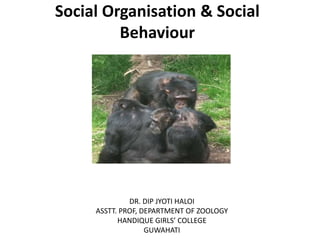
Social organization & Social behavior in animals
- 1. Social Organisation & Social Behaviour DR. DIP JYOTI HALOI ASSTT. PROF, DEPARTMENT OF ZOOLOGY HANDIQUE GIRLS’ COLLEGE GUWAHATI
- 2. Social organisation Many animals live in social groups and have behaviours that are adapted to group living, such as social hierarchy or cooperative hunting and defence. Social organisation of a group of animal depends on the total no of individuals, their age, sex, sex ratio, no of adult males. These in turn depends on the factors like abundance, availability & dispersion of food, predation pressure, type of habitat & mating strategies.
- 3. Basis of social life: The basis of social life is the interaction of individual members who exchange food, water, body care and sexual favours. According to Tinbergen – Any interaction between one individual of a species with another member of the same species is known as social behavior. These include- all those behaviors that influence or are influenced by other members of same species.
- 4. A true society will involve more than one mated pair i,e., adults, sub-adults, juveniles, infants of different age-sex classes. It will mean a stable group whose members inter – communicate extensively and bear some relatively permanent relationship to one another.
- 5. Characteristics of social groups(Wilson & Brown,1975) Members of the same group of animals come together & stay together in a group. Social behavior depends in part on the “ Length of time or part of life cycle that the group remain together”. That means energy actually spent by animals in social behavior. “Reciprocal communication” is a mechanism for attracting and keeping members of a group together. Communication may be auditory, visual, chemical or tactile.
- 6. Division of labour is very prominent. Overlapping of generations. Altruistic or Aid giving behavior where there is a cost to the altruistic animal.
- 7. Properties of organized animal societies (Eisenberg,1965) • Communication: Posture, gesture, colour change, raise hair, scent marking, vocalization, touch etc. • Cohesion: Bee society, herd of deer, pride of linos, peck of wolves, troop of baboon, group of monkeys. ADM leads the group, ADM remain closer to females, ASM takes dangerous positions.
- 8. Division of labour: Different age groups/sexes take diffferent positions. In baboon troops YAM serves always as front/rear guard. To face danger ASM leave the center come to front followed by ADM. Permanence & impermeability: In most mammals the core of the society is formed by the females who are related to each other, the males come & go. The membership among female is permanent. Many societies resist immigration by outsiders.
- 9. Individual social interactions: • Communication • Courtship mating • Parental care • Aggressive interactions • Territoriality • Physical proximity • Grooming
- 10. Advantages of being social: Antipredation: Improved detection of predators with more eyes & ears. There is an increased cahnce that one or more membres will detect the predator before the others & will warn the rest of the group. Dilution effect: Larger the group, lower is the probability that a single individual will be the target of a population. Guard Behaviuor: One or few animals assume the role of watching for the entire groups, thus freeing the others from the job of vigilance. Mutual vigilence: Social animals living in same habitat respond to the alarm calls given by members of other species. E.g Baboons,, Zebras, gazelles.
- 11. Mobbing running away or fleeing is being the most commonly used antipredatory strategy among animals. Feeding efficiency & information sharing: It is easier for a group of animals to catch a prey instead of catching it alone or cooperative foraging is beneficial. It improves foraging capacity & foraging time. Co-operation improves the ability of carnivores to protect carcasses from scavengers. A single lion is unable to prevent a peck of hyenas or wild dogs from stealing a carcass, but two or more lions can. Facilitation of reproduction: Group living improves reproductive success. In solitary animals like Rhino, orangutang it is difficult for them to find a mate or they will have to caver large areas in forest, spend time & energy to find a suitable mate. But for animals living in groups finding mate becomes very easier since they live in close proximity.